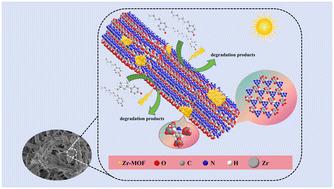基于MOF-808-NH2和TpTt-COF的s型异质结设计用于可见光下增强烷基酚光催化降解
IF 4.2
3区 化学
Q2 CHEMISTRY, PHYSICAL
引用次数: 0
摘要
烷基酚作为内分泌干扰物,对水生生物和人类健康构成潜在威胁。它们的光降解效率随着烷基链和支链构型的缩短而降低。MOF-808-NH2和TpTt-COFs作为光催化剂,其降解能力有限,且传统的合成方法耗时且复杂。本文采用一锅水热法合成了基于MOF-808-NH2和TpTt-COFs的s型异质结。本研究结果表明,负载结构(MOF-808-NH2)2/(TpTt-COF)8(重量比为2:8)对6种APs的光催化去除率超过97%(在120 min内),具有优异的稳定性和光催化性能,在可见光下具有广泛的适用性。Zr-MOF2/TpTt-COF8的降解率是MOF-808-NH2的2.47倍。进一步验证了该光催化剂的机理为s型异质结电子转移模型,促进了载流子的高效分离。并对降解途径进行了预测,表明降解产物对生物体的毒性逐渐降低。本研究不仅为高效降解环境水中APs提供了可行的途径,展示了相对于以往研究成果的优势和改进,而且为新型可见光光催化剂的设计提供了新的思路。本文章由计算机程序翻译,如有差异,请以英文原文为准。

Designing an S-scheme heterojunction based on MOF-808-NH2 and TpTt-COF for enhanced photocatalytic degradation of alkylphenols under visible light†
Alkylphenols (APs), as endocrine disruptors (EDCs), pose potential threats to aquatic organisms and human health. Their photodegradation efficiency decreases with shorter alkyl chains and branched configurations. MOF-808-NH2 and TpTt-COFs, serving as photocatalysts, exhibit limited degradation capabilities and suffer from time-consuming and complex traditional synthesis methods. Herein, an S-scheme heterojunction based on MOF-808-NH2 and TpTt-COFs was synthesized using a time-efficient one-pot hydrothermal method. The findings of this study indicate that the loaded structure (MOF-808-NH2)2/(TpTt-COF)8 (with a weight ratio of 2 : 8) demonstrates over 97% effective photocatalytic removal of six APs (within 120 min), along with excellent stability and photocatalytic performance and broad applicability under visible light. The degradation rate of Zr-MOF2/TpTt-COF8 is 2.47 times higher than that of MOF-808-NH2. The mechanism of this photocatalyst was further verified as an S-scheme heterojunction electron-transfer model, facilitating the efficient separation of charge carriers. Additionally, the degradation pathway was predicted, showing that the toxicity of degradation products to organisms gradually decreases. This study not only provides a feasible approach for the efficient degradation of APs in environmental water, demonstrating advantages and improvements over previous research findings, but also offers new insights for the design of novel visible-light photocatalysts.
求助全文
通过发布文献求助,成功后即可免费获取论文全文。
去求助
来源期刊

Catalysis Science & Technology
CHEMISTRY, PHYSICAL-
CiteScore
8.70
自引率
6.00%
发文量
587
审稿时长
1.5 months
期刊介绍:
A multidisciplinary journal focusing on cutting edge research across all fundamental science and technological aspects of catalysis.
Editor-in-chief: Bert Weckhuysen
Impact factor: 5.0
Time to first decision (peer reviewed only): 31 days
 求助内容:
求助内容: 应助结果提醒方式:
应助结果提醒方式:


